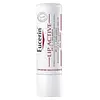What's inside
What's inside
 Key Ingredients
Key Ingredients

 Benefits
Benefits

 Concerns
Concerns

 Ingredients Side-by-side
Ingredients Side-by-side

Cera Microcristallina
Emulsion StabilisingOctyldodecanol
EmollientHydrogenated Polydecene
EmollientRicinus Communis Seed Oil
MaskingCetyl Palmitate
EmollientPolyglyceryl-3 Diisostearate
EmulsifyingPanthenol
Skin ConditioningEthylhexyl Triazone
UV AbsorberButyl Methoxydibenzoylmethane
UV AbsorberCetearyl Alcohol
EmollientBis-Diglyceryl Polyacyladipate-2
EmollientMyristyl Myristate
EmollientC20-40 Alkyl Stearate
Skin ConditioningGlycerin
HumectantCopernicia Cerifera Cera
EmollientWater
Skin ConditioningTocopheryl Acetate
AntioxidantSimmondsia Chinensis Seed Oil
EmollientButyrospermum Parkii Butter
Skin ConditioningBisabolol
MaskingCera Alba
EmollientCera Microcristallina, Octyldodecanol, Hydrogenated Polydecene, Ricinus Communis Seed Oil, Cetyl Palmitate, Polyglyceryl-3 Diisostearate, Panthenol, Ethylhexyl Triazone, Butyl Methoxydibenzoylmethane, Cetearyl Alcohol, Bis-Diglyceryl Polyacyladipate-2, Myristyl Myristate, C20-40 Alkyl Stearate, Glycerin, Copernicia Cerifera Cera, Water, Tocopheryl Acetate, Simmondsia Chinensis Seed Oil, Butyrospermum Parkii Butter, Bisabolol, Cera Alba
Ricinus Communis Seed Oil
MaskingCera Microcristallina
Emulsion StabilisingCocoglycerides
EmollientOctocrylene
UV AbsorberDibutyl Adipate
EmollientParaffin
PerfumingEthylhexyl Salicylate
UV AbsorberButyl Methoxydibenzoylmethane
UV AbsorberCopernicia Cerifera Cera
EmollientEthylhexyl Triazone
UV AbsorberOctyldodecanol
EmollientDiethylamino Hydroxybenzoyl Hexyl Benzoate
UV FilterLanolin
EmollientGlycol Montanate
Emulsifying1,2-Hexanediol
Skin ConditioningParfum
MaskingCaprylyl Glycol
EmollientShorea Robusta Resin
TonicShorea Stenoptera Seed Butter
EmollientTocopheryl Acetate
AntioxidantCI 77891
Cosmetic ColorantBisabolol
MaskingBHT
AntioxidantTropolone
Skin ConditioningTriethoxycaprylylsilane
Tocopherol
AntioxidantCI 15850
Cosmetic ColorantRicinus Communis Seed Oil, Cera Microcristallina, Cocoglycerides, Octocrylene, Dibutyl Adipate, Paraffin, Ethylhexyl Salicylate, Butyl Methoxydibenzoylmethane, Copernicia Cerifera Cera, Ethylhexyl Triazone, Octyldodecanol, Diethylamino Hydroxybenzoyl Hexyl Benzoate, Lanolin, Glycol Montanate, 1,2-Hexanediol, Parfum, Caprylyl Glycol, Shorea Robusta Resin, Shorea Stenoptera Seed Butter, Tocopheryl Acetate, CI 77891, Bisabolol, BHT, Tropolone, Triethoxycaprylylsilane, Tocopherol, CI 15850
Ingredients Explained
These ingredients are found in both products.
Ingredients higher up in an ingredient list are typically present in a larger amount.
Bisabolol is famous for its skin soothing properties. It does this by blocking inflammatory signals, helping to reduce your body's reaction to irritation.
This ingredient also interferes with the process of hyperpigmentation. This can help with reducing dark spots and uneven tone.
Bisabolol is an antioxidant. Antioxidants help fight free-radicals. Free-radicals are molecules that may damage your skin cells. By fighting these free-radicals, Bisabolol may slow down signs of aging.
Studies have shown Bisabolol to have antimicrobial properties and may be a fungicide. These properties help preserve a product's shelf life.
All these properties makes bisabolol a great skin barrier helper ingredient.
Bisabolol also helps the absorption of other ingredients.
Note: Synthetic Bisabolol has been shown to be less effective.
Learn more about BisabololAlso known as Avobenzone, this ingredient is a chemical sunscreen filter that provides protection in the UV-A range.
Avobenzone is globally approved and is the most commonly used UV-A filter in the world.
Studies have found that avobenzone becomes ineffective when exposed to UV light (it is not photostable; meaning that it breaks down in sunlight). Because of this, formulations that include avobenzone will usually contain stabilizers such as octocrylene.
However, some modern formulations (looking at you, EU!) are able to stabilize avobenzone by coating the molecules.
Avobenzone does not protect against the UV-B range, so it's important to check that the sunscreen you're using contains other UV filters that do!
The highest concentration of avobenzone permitted is 3% in the US, and 5% in the EU.
Learn more about Butyl MethoxydibenzoylmethaneCera Microcristallina isn't fungal acne safe.
This ingredient comes from a palm tree native to Brazil. This ingredient is used to thicken texture and leaves behind a film when applied.
Ethylhexyl Triazone is a modern chemical sunscreen that protects from UV-B radiation.
It is the most effective of existing UV-B filters, as it provides the highest level of photo-stable absorption. It protects from the entire UV-B range (280 to 320nm), with it's highest level of protection at 314nm.
Ethylhexyl Triazone is oil soluble, oderless and colorless, which mean it is able to be incorporated into a variety of different formulations.
It is not currently available within the United States due to slow changing FDA regulations. Outside of the US, it is used in formulations at concentrations up to 5%.
Learn more about Ethylhexyl TriazoneOctyldodecanol is a fatty alcohol. It is primarily used to enhance the texture of products.
As an emulsifier, Octyldodecanol helps prevent the oils and waters from separating. It also prevents ingredients from creating foam when shaken.
Octyldodecanol is created by reducing fatty acid to an alcohol.
Due to its high molecular weight, it does not get absorbed into the skin.
Learn more about OctyldodecanolRicinus Communis Seed Oil is the INCI name for castor oil.
Castor Oil helps moisturize the skin. It is rich in a fatty acid called ricinoleic acid. This fatty acid helps prevent moisture loss on the skin. This helps keep your skin soft and hydrated. Ricinoleic acid also has anti-inflammatory and pain reducing properties.
Besides hydrating the skin, castor oil is also used to hydrate hair. By keeping the hair shaft moisturized, breakage is decreased. More studies are needed to show castor oil's effective on stimulating hair growth.
Castor oil is created by cold-pressing castor seeds and then purifying the oil with heat. It was used in Ancient Egypt as fuel in lamps and to help treat eye irritation.
The term 'fragrance' is not regulated in many countries. In many cases, it is up to the brand to define this term. For instance, many brands choose to label themselves as "fragrance-free" because they are not using synthetic fragrances. However, their products may still contain ingredients such as essential oils that are considered a fragrance.
Learn more about Ricinus Communis Seed OilTocopheryl Acetate is AKA Vitamin E. It is an antioxidant and protects your skin from free radicals. Free radicals damage the skin by breaking down collagen.
One study found using Tocopheryl Acetate with Vitamin C decreased the number of sunburned cells.
Tocopheryl Acetate is commonly found in both skincare and dietary supplements.
Learn more about Tocopheryl Acetate